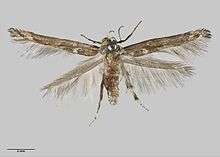Stathmopoda albimaculata
Stathmopoda albimaculata is a species of moth in the Stathmopodidae family. It is endemic to New Zealand. It is classified as Nationally Endangered by the Department of Conservation.
| Stathmopoda albimaculata | |
|---|---|
 | |
| Female holotype specimen held at Auckland Museum | |
| Scientific classification | |
| Kingdom: | |
| Phylum: | |
| Class: | |
| Order: | |
| Family: | |
| Genus: | |
| Species: | S. albimaculata |
| Binomial name | |
| Stathmopoda albimaculata | |
Taxonomy
S. albimaculata was described by Alfred Philpott in 1931.[3][4] Philpott used a female moth collected by Charles E. Clarke at Woodside, Taieri in December.[4] This holotype specimen is held at the Auckland War Memorial Museum.[5] George Vernon Hudson also used this specimen to describe and figure the species in his 1939 publication A supplement to the butterflies and moths of New Zealand.[6]
Distribution
It is endemic to New Zealand.[2] As well as being collected at Taieri, this species has also been found in central and western Otago, The Catlins, Southland, and the Waitaki Valley.[7]
Habitat and ecology
This species inhabits areas from 50m up to 900m in elevation.[7] Along with habitat that includes the various Olearia species that host S. albimaculata, this moth has also been found to inhabit lowland podocarp/hardwood forest.[8] Adult moths are on the wing between the months of October and February.[7] They are most common in January and February.[7]
Host plants
The species is associated with the nationally endangered plant Olearia hectorii,[9] as well as Olearia odorata and Olearia virgata.[7]
Conservation status
S. albimaculata has been classified under the New Zealand Threat Classification system as being Nationally Endangered.[1]
References
- Hoare, R.J.B.; Dugdale, J.S.; Edwards, E.D.; Gibbs, G.W.; Patrick, B.H.; Hitchmough, R.A.; Rolfe, J.R. (2017). Conservation status of New Zealand butterflies and moths (Lepidoptera), 2015 (PDF). Wellington, New Zealand: New Zealand Department of Conservation. p. 6. ISBN 9781988514383.
- "Stathmopoda albimaculata Philpott, 1931". www.nzor.org.nz. Landcare Research New Zealand Ltd. Retrieved 2 May 2018.
- Dugdale, J. S. (1988). "Lepidoptera - annotated catalogue, and keys to family-group taxa" (PDF). Fauna of New Zealand. 14: 108 – via Landcare Research New Zealand Ltd.
- Philpott, Alfred (1931). "Notes and descriptions of New Zealand Lepidoptera". Transactions and Proceedings of the New Zealand Institute. 62: 26–36.
- "Stathmopoda albimaculata". www.AucklandMuseum.com. Auckland War Memorial Museum. Retrieved 2 May 2018.
- Hudson, George Vernon (1939). A supplement to the butterflies and moths of New Zealand. Wellington: Ferguson & Osborn Ltd. p. 456.
- Patrick, B. H. (2000). Lepidoptera of small-leaved divaricating Olearia in New Zealand and their conservation priority (PDF). Wellington, N.Z.: New Zealand Department of Conservation. p. 21. ISBN 0478220154. OCLC 48661253.
- Scott Hooson (2 September 2014). Christchurch District Plan Site of Ecological Significance: Breitmeyers (PDF) (Report). Christchurch City Council. pp. 1–17. Retrieved 2 May 2018.
- Mt Aspiring Station Conservation Resources Report Part 1 (Report). Department of Conservation. November 2005. pp. 1–62. Retrieved 2 May 2018.
External links
| Wikimedia Commons has media related to Stathmopoda albimaculata. |
